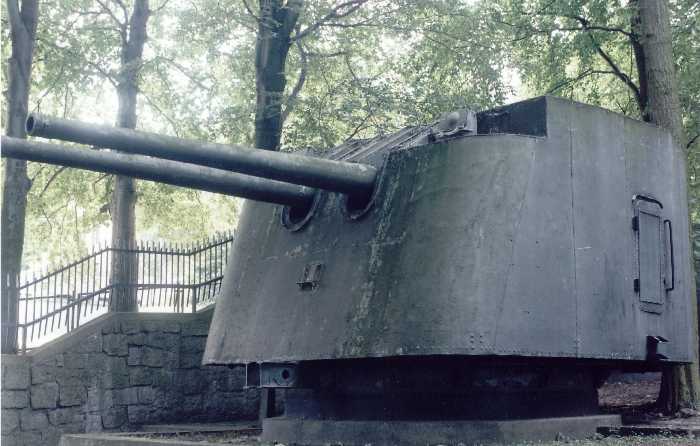
The origins of this weapon go back to 1929, when the design of a 130 mm/45 (5.1") submarine "wet-mount" gun was started. This weapon was to have high barrel pressure in order to match the performance of the 130 mm/55 (5.1") Pattern 1913 gun. However, this design turned out to be too big for the "Pravda" class submarines. For that reason, the design was modified to allow it to be used on destroyers. Changes included lengthening the barrel to 50 calibers and lowering the barrel pressure. Wet mount features, such as using fixed ammunition, were also dropped in order to reduce the cost of this weapon. After many delays, the weapon was tested and accepted into service in 1936. Curiously, serial production actually started in May 1935. This might have been due to the fact that the Destroyer Leader Leningrad was launched in 1933 but had remained incomplete awaiting delivery of these guns.
The desire to keep the same ballistics as the 13 cm/55 (5.1") gun led to an increased barrel pressure, which in turn led to a very short barrel life of only 130 rounds. This meant that Pr. 1 Leaders and Pr. 7/7U Destroyers couldn't even empty their magazines a single time before needing to change out the barrel. After many design changes (including trying to manufacture a polygonal gun barrel), the remedy was found to be making a liner with deeper grooves. The original liner had 1.0 mm (0.039") deep grooves, while the new liner had 2.7 mm (0.106") deep grooves. In the end the fleet was equipped with what amounted to be three different guns, a design with 1.0 mm (0.039") grooves, a design with 1.95 mm (0.077") grooves and a design with 2.7 mm (0.106") grooves. Unfortunately, this meant that the guns, ammunition and range tables were all incompatible with each other, which greatly complicated the logistics for these weapons. By 1941 there were 378 guns in service, most of which were of the deepest groove type.
These weapons were widely used in World War II and remained in production until 1954 with a grand total of 1,199 guns being manufactured.
Prior to the start of World War II a development of the DP version of the B-2 turret was started. This turret was designated as B-2-U (U meaning Universal'naya - Universal). It was to use a barrel extended to 55 calibers. These turrets were intended to be used on the next generation of destroyers and destroyer leaders, but the war stopped the project and none were built.
Overall this was a good destroyer gun in its later incarnations. However, it was only slightly lighter than the older 13 cm/55 (5.1") Pattern 1913 and had a breech mechanism that never seemed to work properly.
Early guns were monobloc but later guns changed to a loose liner.
| Designation | 130 mm/50 (5.1") B13 Pattern 1936 |
|---|---|
| Ship Class Used On | Leningrad (Pr. 1), Minsk (Pr. 38), Baku (Pr. 38bis), Tashkent (Pr. 20), Project 47 and
Project 48 class DLs
Gnevnyi (Pr.7), Storozhevoi (Pr.7U), Opitnyi (Pr. 45), Ognyevoi (Pr. 30 in all its incarantions), Project 35 and Project 40 Class DDs Khasan (Pr. 1190), Shilka (Pr. SB-30) class monitors Also used on auxiliary ships, river craft, coastal batteries and railway guns |
| Date Of Design | 1929-35 |
| Date In Service | 1936 |
| Gun Weight | 5.0 tons (5.07 mt) |
| Gun Length oa | 259.1 in (6.581 m) |
| Bore Length | 253.9 in (6.450 m) |
| Rifling Length | 204.7 in (5.199 m) |
| Grooves | 40 |
| Lands | N/A |
| Twist | N/A |
| Chamber Volume | 17.53 dm3 |
| Rate Of Fire | B-13 Single Mount: 6 - 10 rounds per minute
B-2LM Twin Mount: 12 rounds per minute B-2LMT Twin Mount: 10-12 rounds per minute B-28 Twin Mount: 6 -10 rounds per minute B-2-U Twin DP Mount: 13 rounds per minute |
| Type | Separate |
|---|---|
| Projectile Types and Weights 1 | SAP mod 1928 (PB-46A): 73.9 lbs. (33.5 kg)
SAP mod 1928 (PB-46): 73.6 lbs. (33.4 kg) HE mod 1828 (F-46): 73.6 lbs. (33.4 kg) HE-FRAG mod 1928 (OF-46): 73.6 lbs. (33.4 kg) HE-FRAG mod 1928 (OFU-46): 75.3 lbs. (34.17 kg) AA mod 1928 (ZS-46): 73.6 lbs. (33.4 kg) AA (ZS-46R): 74.5 lbs. (33.8 kg) Diving: 73.1 lbs. (33.15 kg) Starshell (SB-46): 76.1 lbs. (34.5 kg) Starshell (SP-46): 72 lbs. (32.67 kg) Anti-Radiation |
| Bursting Charge | SAP mod 1928 (PB-46A): 5.18 lbs. (2.35 kg)
SAP mod 1928 (PB-46): 3.68 lbs. (1.67 kg) HE mod 1828 (F-46): 5.98 lbs. (2.71 kg) HE-FRAG mod 1928 (OF-46): 7.89 lbs. (3.58 kg) HE-FRAG mod 1928 (OFU-46): 5.95 lbs. (2.7 kg) AA mod 1928 (ZS-46): 5.82 lbs. (2.64 kg) AA (ZS-46R): 4.67 lbs. (2.12 kg) Diving: 14.24 lbs. (6.46 kg) Starshell (SB-46): 0.07 lbs. (0.03 kg) Starshell (SP-46): 0.11 lbs. (0.05 kg) Anti-Radiation: none |
| Projectile Length | SAP mod 1928 (PB-46A): 5 calibers
SAP mod 1928 (PB-46): 4.82 calibers HE mod 1828 (F-46): 4.9 calibers HE-FRAG mod 1928 (OF-46): 5.15 calibers HE-FRAG mod 1928 (OFU-46): 5 calibers AA mod 1928 (ZS-46): 5 calibers AA (ZS-46R): 4.9 calibers Diving: 4.98 calibers Starshell (SB-46): 4.9 calibers Starshell (SP-46): 4.4 calibers |
| Propellant Charge | Combat: 24.25 lbs. (11 kg)
Reduced: 11.02 lbs. (5 kg) Special for Diving round: 2.05 lbs. (0.93 kg) Special for Starshell: 16.98 lbs. (7.7 kg) |
| Muzzle Velocity |
|
| Working Pressure | 3000 kg/cm2 |
| Approximate Barrel Life | Shallow grooves: 130 rounds
Deep grooves: 1100 rounds |
| Ammunition stowage per gun | Pr. 7 DDs: 100 rounds
150 rounds for the rest |
- ^There were many different types of ammunition for these guns, as well as needing to be of three different styles depending upon the rifling groove depth.
| Shell | Elevation | Distance |
|---|---|---|
| SAP mod 1911 | 45 degrees | 22,245 yards (20,341 m) |
| 73.6 lbs. (33.4 kg) (PB-46), (OF-46), (OFU-46) | 28,140 yards (25,731 m) | |
| 73.6 lbs. (33.4 kg) AA mod 1928 | 24402 yards (22,314 m) | |
| 73.1 lbs. (33.15 kg) Diving | 3.500 yards (3,200 m) | |
| 76.1 lbs. (34.5 kg) Star Shell (SB-46) | 11,601 yards (10.608 m) |
| Elevation | Distance |
|---|---|
| 45 degrees | 27,903 yards (25,515 m) |
| Shell | Elevation | Distance |
|---|---|---|
| 73.6 lbs. (33.4 kg) (PB-46), (PB-46A), (OF-46), (F-46) | 45 degrees | 27,993 yards (25,597 m) |
| 73.6 lbs. (33.4 kg) AA mod 1928 | 24402 yards (22,314 m) | |
| 73.1 lbs. (33.15 kg) Diving | 3.401 yards (3,110 m) |
| Designation |
|
|---|---|
| Weight | B-13: 11.8 tons (12.0 mt) B-2LM: 48.23 tons (49 mt) B-2LMT: 89.48 tons (90.9 mt) B-28: 82.39 tons (83.7 mt) B-2-U: 47.64 tons (48.4 mt) |
| Elevation | All: -5 / +45 degrees B-2-U: -6 / +85 degrees |
| Rate of Elevation | B-13: 5 degrees per second B-2LM: 9.85 degrees per second B-2LMT: 10 degrees per second B-28: 6 degrees per second B-2-U: 12 degrees per second |
| Train | about -150 / +150 degrees |
| Rate of Train | B-13: 5 degrees per second B-2LM: 9.7 degrees per second B-2LMT: 10 degrees per second B-28: 8 degrees per second B-2-U: 20 degrees per second |
| Gun Recoil | 19.68 to 19.88 in (50 to 50.5 cm) |
| Loading Angle | All except Twin Mount B-28: Any angle Twin Mount B-28: 0 / +45 degrees |
- ^The B-13 mount had sharp corners while the B-13-2 mount had rounded corners. Both variations were often used on the same ship, apparently depending upon what was available during construction. These were open-back shielded mounts. Lower mountings were protected from upper mount blast by having an extended roof.
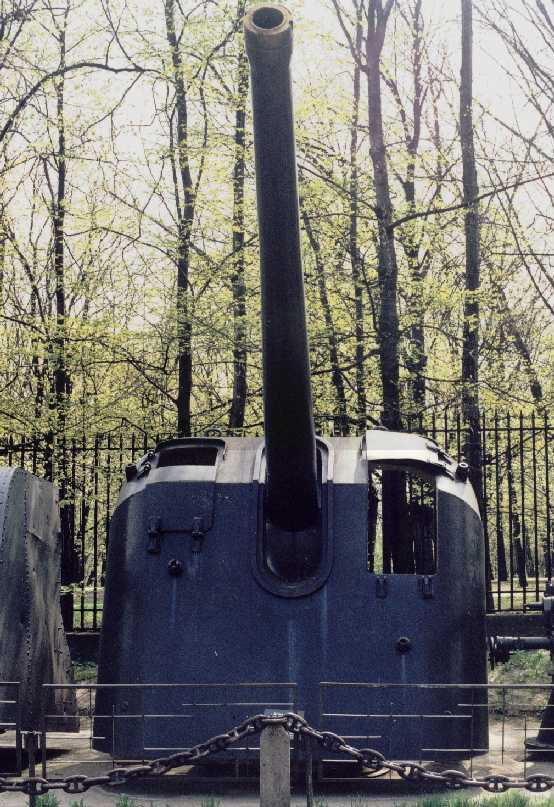
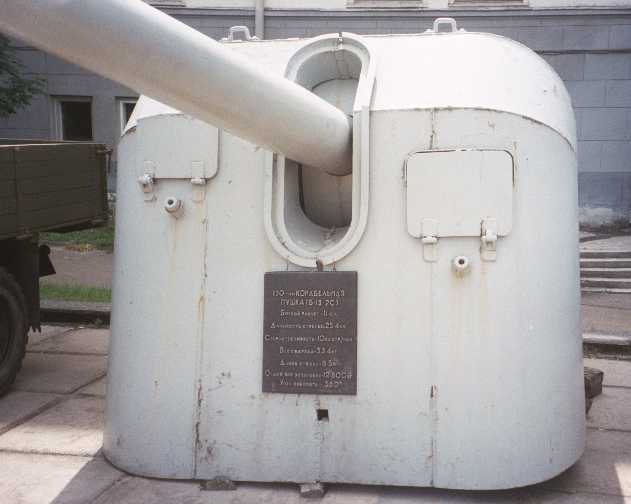
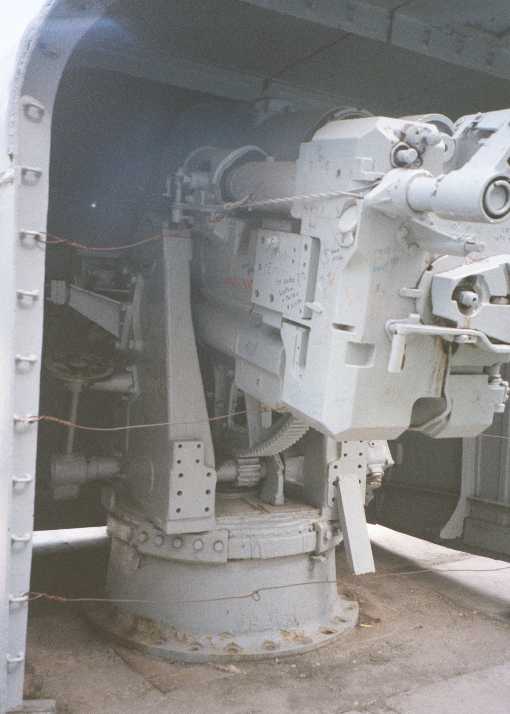
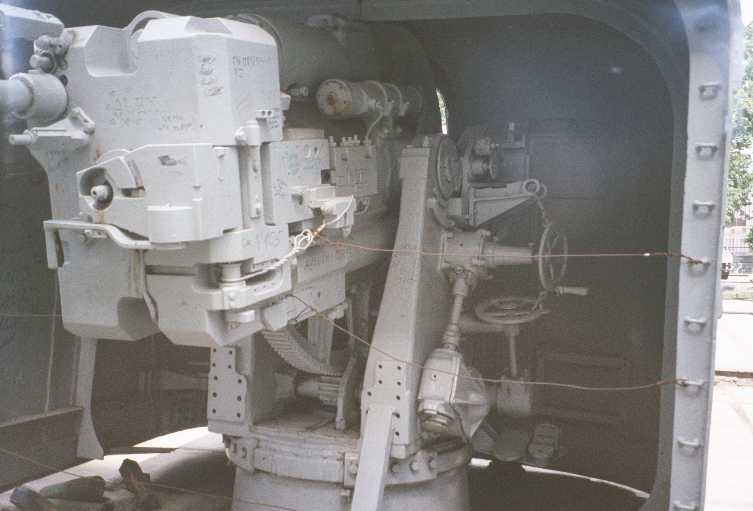

130 mm/50 B13 at Moscow Victory Park - Pictures by Vladimir Yakubov
"Naval Weapons of World War Two" by John Campbell
"Soviet Destroyers of World War II" by Alexander Hill
"Sovetskie Boevye Korabli 1941-45: IV Vooruzhnie" (Soviet Warships 1941-45: Volume IV Armament) by A.V. Platonov
"Entsiklopedia Otechestvennoi Artillerii" (Encyclopedia of Fatherland (Russian) Artillery) by A.V. Shirokorad
"Destroyers of World War Two" and "Cruisers of World War Two" both by M.J. Whitley
---
Special help from Vladimir Yakubov
11 September 2006 - Benchmark
29 May 2018 - Converted to HTML 5, reorganized notes, added information on differences between B-13 and B-13-2 mountings
